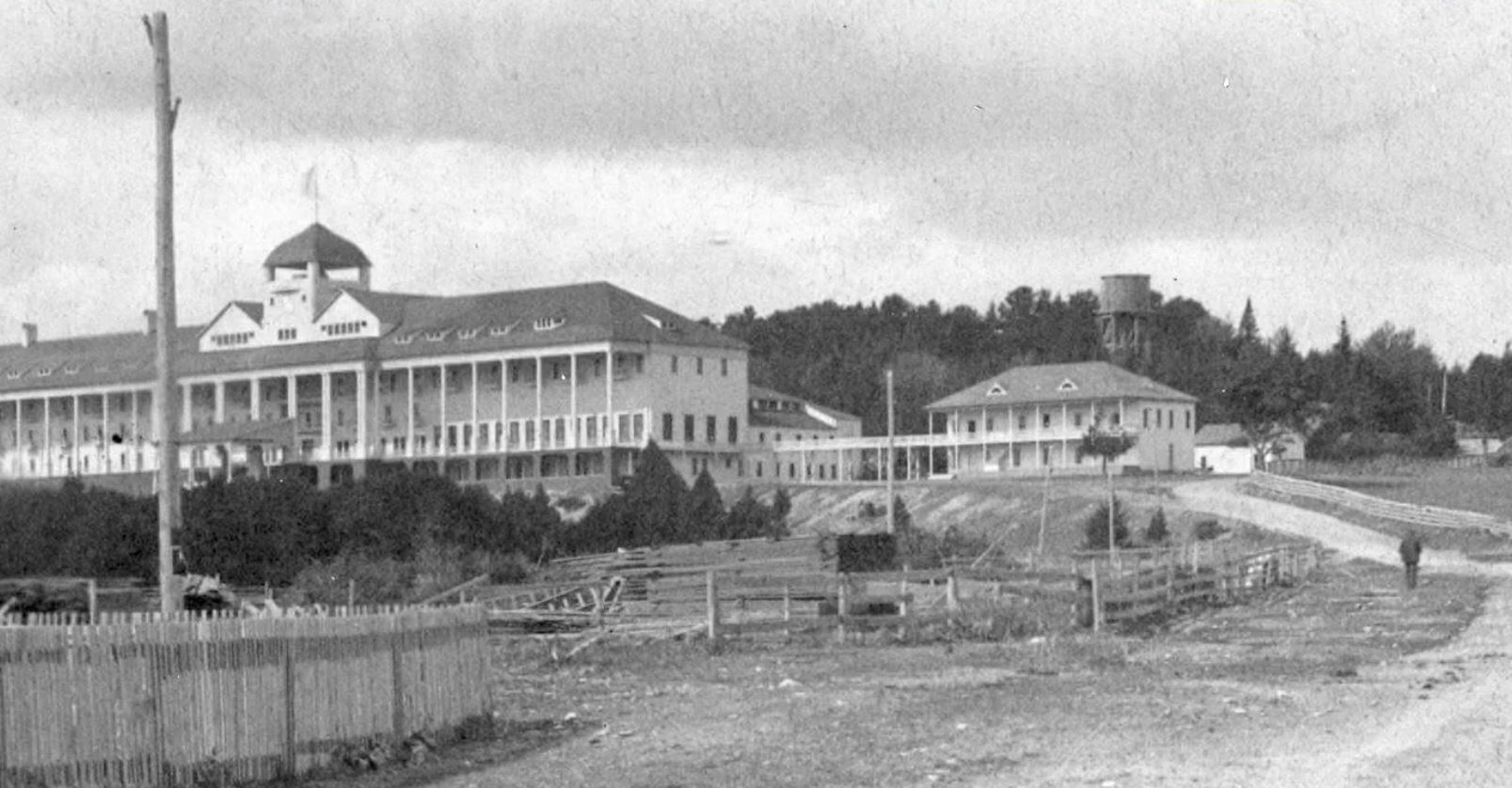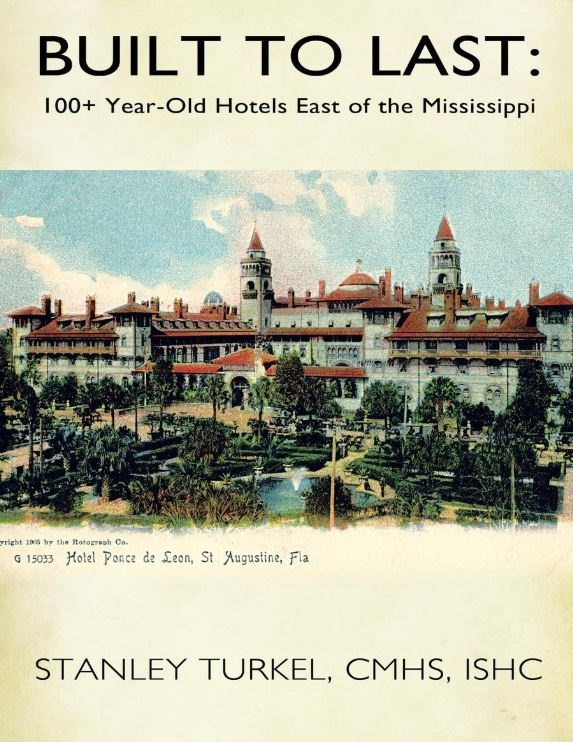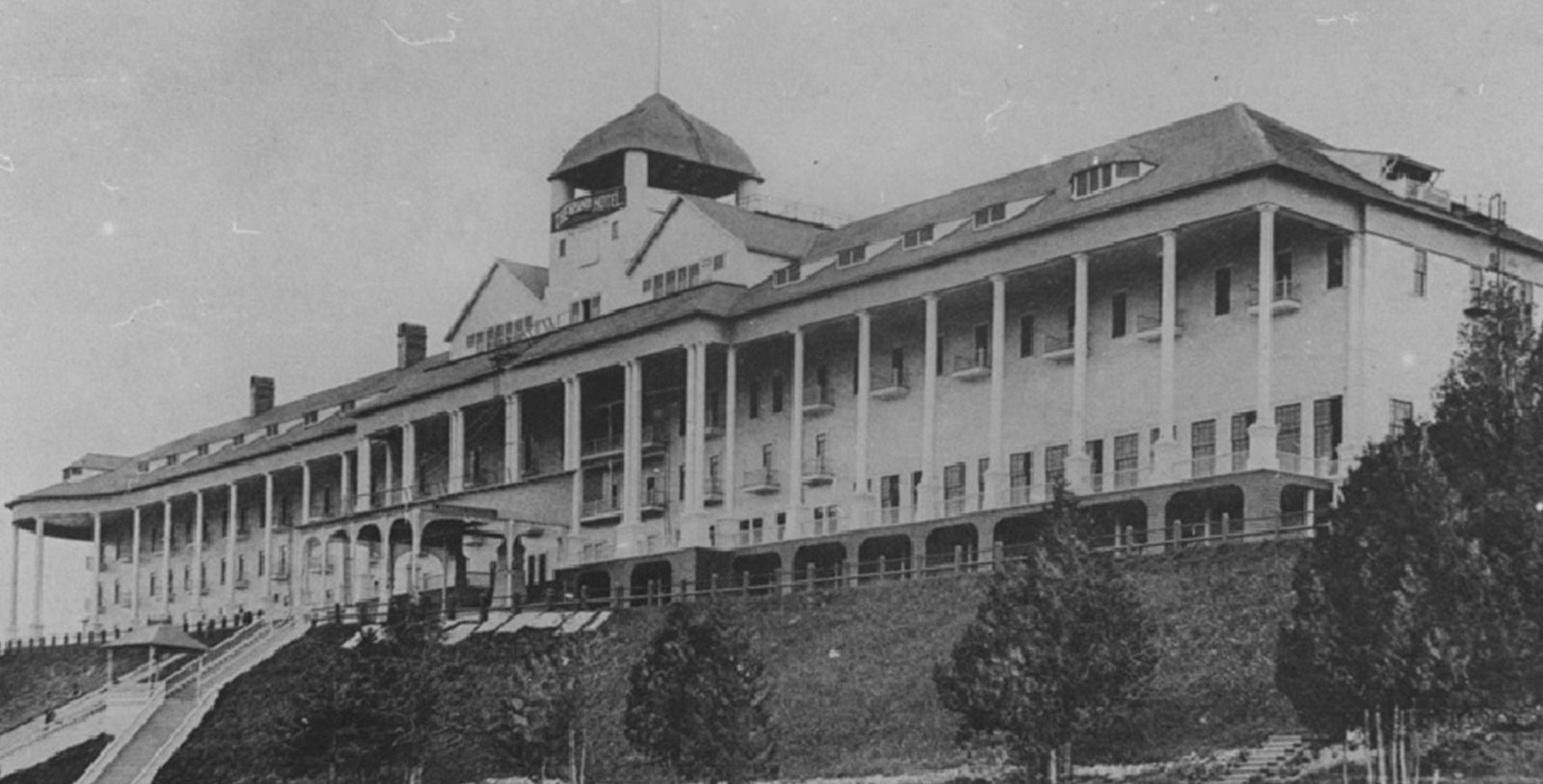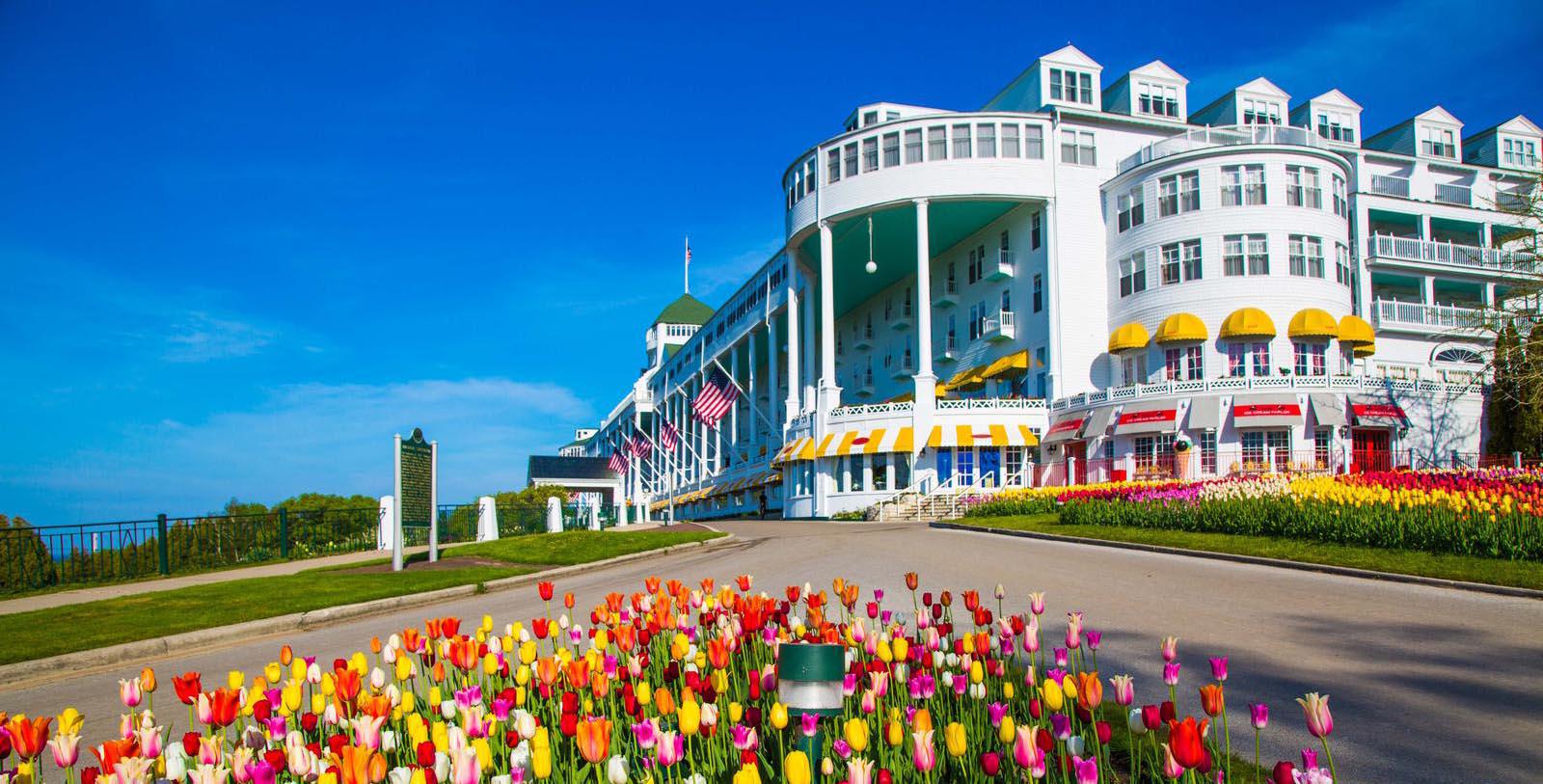Receive for Free - Discover & Explore eNewsletter monthly with advance notice of special offers, packages, and insider savings from 10% - 30% off Best Available Rates at selected hotels.
history
Discover Grand Hotel, which was a summer retreat for vacationers on Mackinac Island who arrived by lake steamer from Chicago or Detroit.

Architectural Design at Grand Hotel, Mackinac Island
Discover who designed Grand Hotel with resident Historian Bob Tagatz.
WATCH NOWA member of Historic Hotels of America since 2001, Grand Hotel on Mackinac Island, Michigan, is one of the last surviving Grand Dames of the Gilded Age. It first opened at a time when Mackinac Island itself was rapidly transforming into a preeminent vacation hotspot for throngs of Midwestern tourists. Sensing opportunity, representatives from the Michigan Central Railroad, the Grand Rapids and Indiana Railroad, and the Detroit and Cleveland Steamship Navigation Company formed the Mackinac Island Hotel Company. These individuals yearned to capitalize upon the nation’s growing desire for recreational travel and saw Mackinac Island as the perfect place to construct a luxurious hotel. To create what they hoped would serve as America’s “Summer Palace,” the group commissioned the talented, Detroit-based architectural firm Mason and Rice to make their dream a reality. Construction then began in earnest and lasted for several months. The work was completely overseen by Charles Caskey, a prominent resort builder who had created a number of seasonal cottages throughout the area. Together with his brother-in-law Alphonse Howe, Caskey gradually created a stunning five-story resort hotel based on plans provided by Mason and Rice. The building soon featured a wealth of outstanding amenities, including dining facilities, meeting spaces, and 286 gorgeous guestrooms. Its exterior radiated stunning Queen Anne-inspired architecture, although accents of American Colonial Revivalism appeared all around the façade, too.
When it finally opened in 1887, Grand Hotel quickly emerged as the preferred destination for vacationers from places like Chicago, Detroit, and Montréal, among other places. The hotel's 600-foor Front Porch soon became the primary meeting spot for anyone on Mackinac Island, especially for island romantics who referred to it as “Flirtation Walk.” A number of leading American figures frequented Grand Hotel around this time as well, including Thomas Edison and Mark Twain. In fact, it was quite common to see Edison play with a few of his inventions while visiting, such as the time when he unveiled his phonograph on the front porch. The hotel even managed to attract such illustrious guests like Presidents Grover Cleveland and Theodore Roosevelt. In 1919, W. Stewart Woodfill joined Grand Hotel as a desk clerk. After serving the business in several capacities over the next few years, he purchased the hotel two decades later amid the Great Depression. Despite the economic uncertainty of the era, Grand Hotel nonetheless reached new heights in its popularity due to Woodfill’s outstanding stewardship. His management succeeded at increasing the number of guests to come to the hotel and even convinced Hollywood producers to shoot portions of the film, This Time for Keeps, on-site. Many influential guests continued to frequent the hotel during his tenure, including additional Presidents like Franklin Delano Roosevelt, Harry S. Truman, and Dwight D. Eisenhower.
R.D. “Dan” Musser joined the staff as a cashier during the 1950s and quickly rose through the ranks to become Woodfill’s most trusted lieutenant. Musser fell in love with the building and eventually purchased it outright from Woodfill in 1979. Under Musser’s watchful eye, the building grew exponentially while also maintaining its grand historical charm. Along with his wife, Amelia, Dan Musser initiated an ongoing series of renovations that continued to preserve the rich heritage of Grand Hotel. Musser and his family subsequently debuted many new facilities throughout the 1970s and 1980s, such as the Woodfill Conference Center and the Cupola Bar. Those facilities were then followed by the likes of Astor’s Hair Salon, Margaret’s Garden, and The Audubon Wine Bar two decades later. The Musser even began installing unique suites named in honor of several First Ladies, beginning with Lady Bird Johnson, Betty Ford, Rosalynn Carter, Nancy Reagan, and Barbara Bush. All the while, Grand Hotel retained its incredibly prestigious identity. A native of Grand Rapids, President Gerald Ford had a high-profile visit to Grand Hotel during his single term in office. The president enjoyed relaxing at Grand Hotel and even played a round on its golf course, now known as “The Jewel Golf Course.” Christopher Reeves, Jane Seymour, and Christopher Plummer then arrived while filming large portions of Jeannot Szwarc’s romantic drama, Somewhere in Time. Like This Time for Keeps, Somewhere in Time was mostly shot inside Grand Hotel itself!
The expansion of the hotel continued into the next century with the construction of the Millennium Wing, which debuted in 2001. This fantastic location features a 300-seat addition to the Main Dining Room, 42 new guestrooms and The Grand Pavilion—a 3,600-square-foot private meeting room and dining room. For years, this spectacular historic hotel has acquired numerous awards and accolades. The Michigan Historical Association first identified Grand Hotel as a State Historical Building in 1957. The U.S. Department of the Interior then listed it on the National Register of Historic Places in 1972, later recognizing it as a National Historic Landmark in 1989. The Michigan Department of Energy, Labor & Economic Growth also certified the hotel as a “Green Lodging Michigan Leader” in 2009, due to the reduction of its own carbon footprint. Grand Hotel is even received a Four-Diamond rating from the American Automobile Association (AAA), and consistently ranks among the best historic hotels in Historic Hotels of America. Indeed, Historic Hotels of America has bestowed Grand Hotel with a few of its prestigious Awards of Excellence, including “Historic Hotels of America Best Historic Restaurant” (2018) and “Historic Hotels of America Best Social Media of a Historic Hotel” (2021). Now under the ownership of KSL Capital Partners, Grand Hotel continues to be one of the most celebrated holiday destinations in the entire country. Its luxury and heritage are certain to enchant generations of guests for decades to come.
-
About the Location +
Located within the Straits of Mackinac, Mackinac Island has been among the nation’s most celebrated holiday destinations since the late Victorian era. People from across the Midwest flocked to the island for its temperate weather and reclusive environment. In order to safeguard its rustic charm, many of the island's permanent residents passed legislation prohibiting vehicles onto the island. This ordnance is still in effect today, which helps to preserve Mackinac Island’s historical character. But before Mackinac Island became an internationally renowned vacation retreat, it once was home to traveling bands of the Anishinaabe. They specifically thought of the island to be scared, believing that the Great Spirit inhabited it following the end of a cataclysmic flood. Indeed, archeologists have since located all kinds of native artifacts along the coastline, including fishhooks, arrowheads, and other items. (Burial mounds for ancient chieftains have even been discovered around the area in recent years, too.) While records regarding the first European to arrive at Mackinac Island are scant, some historians speculate that it was Jean Nicolet during his journey to modern-day Wisconsin in the 17th century. Priest Claude Dablon then arrived several decades later to establish a short-lived mission on Mackinac Island. Jacques Marquette eventually replaced him in 1671, who decided to relocate the facility to St. Ignace. Nevertheless, a small fur trading outpost emerged on Mackinac Island, as the nearby Straits of Mackinac became an important nexus in French Canada.
Mackinac Island fell under British control during the late 18th century. Major Patrick Sinclair specifically landed during the American Revolutionary War and built a citadel called “Fort Mackinac.” Despite its imposing nature, Fort Mackinac was never attacked during the conflict. In fact, the British eventually surrendered the base to the nascent United States military at the end of the war! However, the British kept their desire to control Fort Mackinac and attempted to seize it outright at the start of the War of 1812. Indeed, the Royal Army managed to surprise the American garrison on-site amid a quick invasion of Mackinac Island. Looking to solidify their hold over the citadel, the British developed another base—Fort George—on the heights behind Fort Mackinac. American commanders yearned to take Mackinac Island and launched their own counteroffensive in 1814. The battle failed with the Americans’ second-in-command, Major Andrew Hunter Holmes, killed in the ensuring gunfight. Mackinac Island ultimately returned to the United States via the Treaty of Ghent, which concluded the war. In its wake, an influential population of Native American and French-speaking fur traders soon moved into the area, giving it a unique identity that was to last for decades. John Jacob Astor even located his American Fur Company on the island, which helped him amass an incredible fortune. The military presence was finally removed when Fort Mackinac closed permanently at the height of the Gilded Age.
Mackinac Island then started to become a popular tourist destination once the federal government made the area a national park during the 1870s. Word quickly spread of the island’s bucolic tranquility, inspiring many from across the Midwest to come and experience its charm. Soon enough, charters were ferrying guests out to Mackinac Island every year, making the site one of the most active places in the Great Lakes. A few transportation companies built a variety of hotels—including Grand Hotel—throughout the remainder of the 19th century, as well. But Mackinac Island was also gradually dotted with quaint seasonal cottages that wealthy industrialists had constructed to serve as their private retreats. As soon as the island reverted to the status of a state park in the 1890s, the newly empowered Mackinac Island State Park Commission took great pains to limit any future real estate developments. Thanks to the legislation, the commission’s actions have since guaranteed that Mackinac Island’s iconic serenity has remained largely untouched well into the present. The island has since preserved its status as one of America’s top vacation destinations, hosting thousands of people every year. Indeed, the island has hosted all kinds of illustrious guests, from Hollywood celebrities to sitting U.S. Presidents. Cultural heritage travelers have particularly enjoyed visiting the island regularly due to the many unique historical landmarks located in the vicinity. The attraction that those guests have found to be the most fascinating is the retired Fort Mackinac, which exists today as a museum open to public exploration.
-
About the Architecture +
In the 1880s, the representatives of the Mackinac Island Hotel Company began constructing a brilliant hotel on Mackinac Island that would capitalize upon the nation’s growing desire for recreational travel. The group subsequently hired the Detroit-based architectural firm, Mason and Rice, to design the project, although Charles Caskey and his brother-in-law—Alphonse Howe—directly oversaw the project. When construction concluded a year later, the building debuted with 286 outstanding accommodations. Grand Hotel’s original owners later installed additional wings to the hotel in 1897 and 1912, which greatly increased the number of the facilities located on-site. Among the buildings constructed around that time are a Superintendent’s Residence, a Carpenter’s Shop, a Powerhouse, a stable for 50 horses, and Grand Hotel’s West Wing. Grand Hotel has since experienced a series of extensive renovations that have sought to modernize it, while also preserving its rich historical ambiance. The Musser family specifically added several new additions in 1987, such as the Woodfill Conference Center and the Cupola Bar. Special boutique shops appeared a few years later in the mid-1990s, like Astor’s Hair Salon, Rebecca’s, Margaret’s Garden, and Grand Hotel & Co., Fine Jewelry. The Mussers also developed a series of suites named in honor of prominent former First Ladies, such as Lady Bird Johnson, Nancy Reagan, and Barbara Bush. (Those suites were then joined by The Jacqueline Kennedy Suite and The Laura Bush Suite during the 2000s.) The construction of this suite coincided with the addition of some 60 other guestrooms, which raised the total number of accommodations at the hotel to 393.
When Mason an Rice first began designing Grand Hotel at the height of the Gilded Age, they specifically used Queen-Anne-style architecture as the main source of their inspiration. A successor to Eastlake architecture, Queen Anne itself became a widely popular architectural style at the height of the Gilded Age. Named in honor of 18th-century British monarch, Queen Anne, the architectural form started in England before migrating to the United States. Yet, its name is misleading, as it actually borrowed its design principles from buildings constructed during the Renaissance. While the appearance of Queen Anne-style buildings may differ considerably, they are all united by several common features. For instance, they are typically asymmetrical in nature, and are built with some combination of stone, brick, and wood. Those buildings also feature a large wrap-around porch, as well as a couple of polygonal towers. Those towers may also be accompanied by turrets along the corners of a building’s exterior façade. Queen Anne structures also have pitched, gabled roofs made with irregular shapes and patterns. Intricate wood carvings are a common sight throughout their layout, too, and are often designed in such a way to resemble different objects like an illusion. Clapboard paneling and half-timbering are a few other forms of woodworking that are regularly found somewhere within a Queen Anne-style structure. Grand Hotel today stands as a brilliant example of preserved Queen Anne-style architecture of the age. In fact, its architectural appearance and integrity played a major role in the U.S. Department of the Interior’s decision to have it designated a U.S. National Historic Landmark.
But Grand Hotel also showcased elements of Colonial Revivalism when it first debuted, too. Colonial Revival architecture today is perhaps the most widely used building form in the entire United States. It reached its zenith at the height of the Gilded Age, where countless Americans turned to the aesthetic to celebrate what they feared was America’s disappearing past. The movement came about in the aftermath of the Centennial International Exhibition of 1876, in which people from across the country traveled to Philadelphia, Pennsylvania, to commemorate the American Revolution. Many of the exhibitors chose to display cultural representations of 18th-century America, encouraging millions of people across the country to preserve the nation’s history. Architects were among those inspired, who looked to revitalize the design principles of colonial English and Dutch homes. This gradually gave way to a larger embrace of Georgian and Federal-style architecture, which focused exclusively on the country’s formative years. As such, structures built in the style of Colonial Revival architecture featured such components as pilasters, brickwork, and modest, double-hung windows. Symmetrical designs defined Colonial Revival-style façades, anchored by a central, pedimented front door and simplistic portico. Gable roofs typically topped the buildings, although hipped and gambrel forms were used, as well. This building remained immensely popular for years until largely petering out in the late-20th century. Nevertheless, architects today still rely upon Colonial Revival architecture, using the form to construct all kinds of residential buildings and commercial complexes.
-
Famous Historic Guests +
Thomas Edison, inventor known for such inventions as the motion picture camera and the light bulb.
Mark Twain, author known for writing The Adventures of Tom Sawyer and Adventures of Huckleberry Finn.
Jimmy Durante, comedian known for his roles in The Great Rupert and It Happened in Brooklyn.
Esther Williams, actress known for her roles in Million Dollar Mermaid and Bathing Beauty.
Christopher Plummer, actor known for his roles in movies like Beginners, The Insiders, and The Sound of Music.
Christopher Reeves, actor best remembered for his role as Superman in the 1978 film of the same name.
Jane Seymour, actress best known for her roles in Live and Let Die and Dr. Quinn: Medicine Woman.
Arnold Palmer, winner of seven major golf championships that include the PGA Championship and the Masters Tournament.
Grover Cleveland, 22nd and 24th President of the United States (1885 – 1889; 1893 – 1897)
Theodore Roosevelt, 26th President of the United States (1901 – 1909)
Franklin Delano Roosevelt, 32nd President of the United States (1932 – 1945)
Harry S. Truman, 33rd President of the United States (1945 – 1953)
Dwight D. Eisenhower, 34th President of the United States (1953 – 1961), and Supreme Allied Commander Europe during World War II.
John F. Kennedy, 35th President of the United States (1961 – 1963)
Gerald Ford, 38th President of the United States (1974 – 1977)
Jimmy Carter, 39th President of the United States (1977 – 1981)
George H.W. Bush, 41st President of the United States (1989 – 1993)
Bill Clinton, 42nd President of the United States (1993 – 2001)
-
Film, TV and Media Connections +
This Time For Keeps (1947)
Somewhere in Time (1980)


Guest Historian Series
Nobody Asked Me, But… No. 208;
Hotel History: Grand Hotel (1887), Mackinac Island, Michigan
By Stanley Turkel, CMHS
The "Grand" as it is called on the island, is a historic coastal resort with a spectacular 660-foot long, three-story high porch. Below this covered veranda is a manicured lawn sloping down to a formal flower garden where 10,000 geraniums bloom in season among other flower beds with wild blossoms. The hotel is located on Mackinac Island which is in the straits between Lake Michigan and Lake Huron. It has thrived because of an important decision made in the 1920s. All private cars and trucks were outlawed on the island which gives visitors a chance to live in a village without automobiles. In their place, islanders depend on bicycles and horse- drawn carriages and wagons. Originally called Plank's Grand Hotel after its builder John Oliver Plank, one of America's top hotel builders and operators in the late 1880s and early 1900s.
In 1886, the Michigan Central Railroad, Grand Rapids and Indiana Railroad, and Detroit and Cleveland Steamship Navigation Company formed the Mackinac Island Hotel Company. The group purchased the land on which the hotel was built and construction began, based upon the design by Detroit architects Mason and Rice. When it opened the following year, the hotel was advertised to Chicago, Erie, Montreal and Detroit residents as a summer retreat for vacationers who arrived by lake steamer and by rail from across the continent. The hotel opened on July 10, 1887 and took a mere 93 days to complete.
The Grand has managed to maintain its 19th century charm and to survive into the age of budget hotels, interstate highways and recreational vehicles. It offers a rare level of luxury with a sense of style that has mostly gone out of style. The meals are American plan featuring five- course breakfasts and formal dinners with jackets and ties on gentlemen and ladies "in their finest". No tipping is permitted at the Grand with an 18% gratuity charge added to every bill.
Five U.S. Presidents have visited: Harry Truman, John F. Kennedy, Gerald Ford, George H.W. Bush and Bill Clinton. The hotel also hosted the first public demonstration of Thomas Edison's phonograph on the porch and regular demonstrations of other new inventions were often conducted during Edison's frequent stays. Mark Twain also made this a regular location on his speaking tours in the Midwest.
Additionally, six suites are named for and designed by seven former First Ladies of the United States, including the Jacqueline Kennedy Suite (with carpet that includes the gold presidential eagle on a navy blue background and walls painted gold), Lady Bird Johnson Suite (yellow damask-covered walls with blue and gold wildflowers), Betty Ford Suite (green with cream and a dash of red), Rosalynn Carter Suite (with a sample of china designed for the Carter White House and wall coverings in Georgia peach), Nancy Reagan Suite (with signature red walls and Mrs. Reagan's personal touches), Barbara Bush Suite (designed with pale blue and pearl and with both Maine and Texas influences) and the Laura Bush Suite.
In 1957, Grand Hotel was designated a State Historical Building. In 1972, the hotel was named to the National Register of Historic Places, and on June 29, 1989, the hotel was made a National Historic Landmark.
The Conde Nast Traveler "Gold Lists" the hotel as one of the "Best Places to Stay in the Whole World" and Travel + Leisure magazine lists it as among the "Top 100 Hotels in the World." The Wine Spectator noted Grand Hotel with an "Award of Excellence" and it made Gourmet magazine's "Top 25 Hotels in the World" list. The American Automobile Association (AAA) rates the facilities as a Four-Diamond resort. In 2009 Grand Hotel was named one of the top 10 U.S. Historic Hotels of America by the National Trust for Historic Preservation.
In 2012, Grand Hotel celebrated its 125th anniversary with a series of memorable events: Saturday night dinner with former Michigan governors in attendance, presentation by Grand Hotel interior designer Carlton Varney, Friday night fireworks, live performance by John Pizzarelli and much more. A special edition 125thanniversary coffee table book was published.
2018 marks Grand Hotel’s 131st Birthday and over 85 years of Musser Family’s ownership.
*****
About Stanley Turkel, CMHS
Stanley Turkel is a recognized consultant in the hotel industry. He operates his hotel consulting practice serving as an expert witness in hotel-related cases and providing asset management an and hotel franchising consultation. Prior to forming his hotel consulting firm, Turkel was the Product Line Manager for worldwide Hotel/Motel Operations at the International Telephone & Telegraph Co. overseeing the Sheraton Corporation of America. Before joining IT&T, he was the Resident Manager of the Americana Hotel (1842 Rooms), General Manager of the Drake Hotel (680 Rooms) and General Manager of the Summit Hotel (762 Rooms), all in New York City. He serves as a Friend of the Tisch Center and lectures at the NYU Tisch Center for Hospitality and Tourism. He is certified as a Master Hotel Supplier Emeritus by the Educational Institute of the American Hotel and Lodging Association. He served for eleven years as Chairman of the Board of the Trustees of the City Club of New York and is now the Honorary Chairman.
Stanley Turkel is one of the most widely-published authors in the hospitality field. More than 275 articles on various hotel subjects have been posted in hotel magazines and on the Hotel-Online, Blue MauMau, Hotel News Resource and eTurboNews websites. Two of his hotel books have been promoted, distributed and sold by the American Hotel & Lodging Educational Institute (Great American Hoteliers: Pioneers of the Hotel Industry and Built To Last: 100+ Year-Old Hotels East of the Mississippi). A third hotel book (Built To Last: 100+ Year-Old Hotels in New York) was called "passionate and informative" by the New York Times. Executive Vice President of Historic Hotels of America, Lawrence Horwitz, has even praised one book, Great American Hoteliers Volume 2: Pioneers of the Hotel Industry:
- “If you have ever been in a hotel, as a guest, attended a conference, enjoyed a romantic dinner, celebrated a special occasion, or worked as a hotelier in the front or back of the house, Great American Hoteliers, Volume 2: Pioneers of the Hotel Industry is a must read book. This book is recommended for any business person, entrepreneur, student, or aspiring hotelier. This book is an excellent history book with insights into seventeen of the great innovators and visionaries of the hotel industry and their inspirational stories.”
Turkel was designated as the “2014 Historian of the Year by Historic Hotels of America,” the official program of the National Trust for Historic Preservation. This award is presented to an individual for making a unique contribution in the research and presentation of history and whose work has encouraged a wide discussion, greater understanding and enthusiasm for American History.
Works published by Stanley Turkel include:
- Heroes of the American Reconstruction (2005)
- Great American Hoteliers: Pioneers of the Hotel Industry (2009)
- Built To Last: 100+ Year-Old Hotels in New York (2011)
- Built To Last: 100+ Year-Old Hotels East of the Mississippi (2013)
- Hotel Mavens: Lucius M. Boomer, George C. Boldt and Oscar of the Waldorf (2014)
- Great American Hoteliers Volume 2: Pioneers of the Hotel Industry (2016)
- Built To Last: 100+ Year-Old Hotels West of the Mississippi (2017)
- Hotel Mavens Volume 2: Henry Morrison Flagler, Henry Bradley Plant, Carl Graham Fisher (2018)
- Great American Hotel Architects Volume 1 (2019)
- Hotel Mavens Volume 3: Bob and Larry Tisch, Curt Strand, Ralph Hitz, Cesar Ritz, Raymond Orteig (2020)
Most of these books can be ordered from AuthorHouse—(except Heroes of the American Reconstruction, which can be ordered from McFarland)—by visiting www.stanleyturkel.com, or by clicking on the book’s title.































